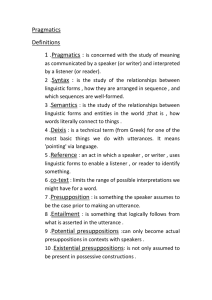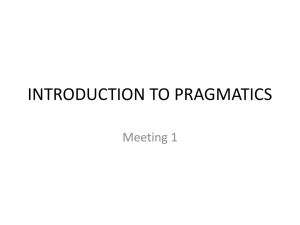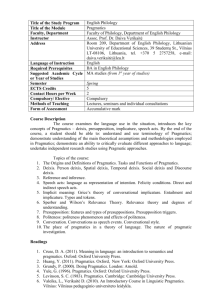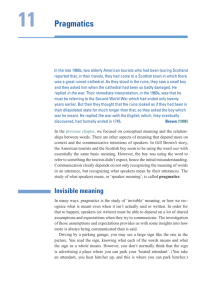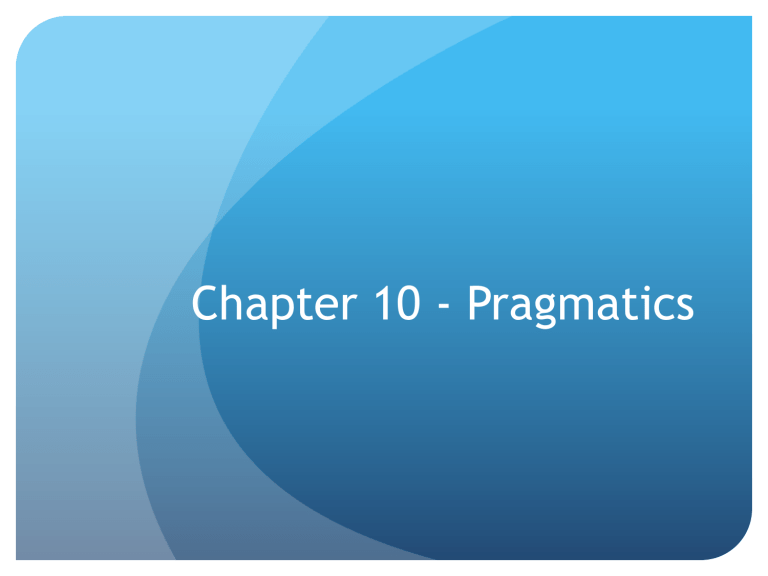
Chapter 10 - Pragmatics
Phoneme Morpheme Word / meaning Clause Sentence/u8erance Pragma9cs Discourse Phonetics and phonology – unit of analysis?
Morphology – unit of analysis?
Syntax – unit of analysis?
Semantics explores the meaning of linguistic units,
typically at the level of words (lexical semantics) or at
the level of sentences or more complex structures
What is Pragmatics?
Pragmatics is:
a systematic way of explaining language use in context.
How utterances are used.
Interpreting what the speaker means
The study of “ invisible” meaning, or how we recognize
what is meant when it isn’t actually written
To understand The meaning
The
meaning
of the
word
knowledge
about the
context
History of pragmatics
It could be traced to two sources:
1- Paul Grice ( logic of conversations)+ Austin & Searl
(Speech acts)
Who formed the basis of formal pragmatics.
2- The sociologist Harvey Sacks ( social interactions).
Who formed the basis of conversation analysis.
Sentences vs. Utterances
Sentences:
A string of words put together by the grammatical rules of a
language
Utterances:
the use of a sentence, in a particular context.
What you actually say
What is actually expressed by words is different from the actual
meaning of the utterance.
pragmatics = utterance meaning.
Utterance meaning consists of the meaning of the
sentence plus considerations of the intentions of the
Speaker (the speaker may intend to refuse the
invitation to go to the film), interpretation of the
Hearer (the Hearer may interpret the utterance as a
refusal, or not), determined by Context and
background knowledge.
Pragmatics is concerned with the meaning and the
intention of the whole text
NOT the meaning of one word.
Context , inten(ons and shared knowledge are the keywords. Also cultural implica(ons play an important role. A.: I have a 14 years old son B.: Well that’s right A.: I also have a dog B.: Oh, I’m sorry It would be hard to catch it, unless you know that A. is trying to rent an apartment from B. and B. doesn’t accept pets. What might be the functions of
the following utterances?
1.
It’s hot in here.
2.
Can you pass me the salt?
3.
I’ll talk to you tomorrow.
4.
It’s a beautiful day today.
Mashael: there is a restaurant over there
Reem: no
Mashael: why not
Reem: I’m tired.
(From a TV serial “Everybody Loves Raymond”)
Debra: Your parents seem nice.
Raymond: Yeah, they seem nice.
Listener
understanding
the speaker’s intentions
Speaker
producing
utterances
Understanding Any message:
knowledge of the meaning of the word
knowledge about the context
Linguistics context
“ Co-text”
Physical context
Linguistics context
The set of other words used in the same phrase or context
Understanding the meaning of the word “
The word fine has many meanings..
How do you decide which meaning is intended in a particular sentence
Linguistics context
- 1- Hi. How are you?
- I’m fine
2- There are several ways you can pay a fine to the
Physical context
the location will influence interpretation
Understanding what we read or hear is related to the
aspects of the physical context.
I want that book ( accompanied by pointing).
Be here at 9:00 tonight. ( place / time reference).
you’ll have to bring them back by tomorrow, because
they aren’t here now and they need them
- The sentence is vague
- It contains many expressions that rely on the knowledge
of the physical context
Deictic/ Deixis
There are many words in the language that cannot be interpreted alone, without being put in a context. Here, there, that, now, I, you, them and many other examples if used without a shared knowledge or a clear context can result very vague. Expressions that we can only understand in terms of the
speaker’s intended meaning.
Deictic comes from Greek and it means ‘pointing via
language
Deictic/ Deixis
1- Person Deixis:
To point to things ( it, this, these boxes) people ( him,
them, her)
2- Spatial ( place) Deixis:
To point to a location ( here, there, near that)
3-Temporal( time) Deixis:
To point to a time ( now, then, last week)
Reference
Words do not refer to themselves.
People refer.
An act by which a speaker uses language to enable the
listener to identify something.
proper nouns ('Shakespeare', 'Hawaii')
- definite noun phrases ('the author', 'the island')
- indefinite noun phrases ('a man’, 'a woman', 'a
beautiful place')
pronouns ('he', 'she', 'them')
Not all referring expressions have
identifiable physical referents
indefinite noun phrases can refer to
• a physically present entity: 'There's a man waiting for
you'
• an unknown entity assumed to exist: 'He wants to marry
a woman with lots of money'
• an entity that does not exist: 'We'd like to sign a ninefoot-tall basketball player'
An attributive use: 'who/whatever fits the description'
Referential use: has one specific entity in mind
The referring expression provides a range of
reference a number of possible referents
Can I borrow your Shakespeare?
Yeah it's over there on the table
Shakespeare takes up the whole bottom shelf
We're going to see Shakespeare in London
I hated Shakespeare at school
The heart-attack mustn't be moved (hospital)
Your ten-thirty just can
celled (dentist)
A couple of rooms have complain
d about the heat (hotel)
Inference
- I saw Shakespeare in London.
- Leena is wearing Marc Jacobs.
- The listener's task is to infer correctly which entity the
speaker intends to identify by using a particular
referring.
- The listener’s ability to recognize what the the speaker
meant
Anaphora
In the film, a man and a woman were trying to wash a cat. The
man was holding the cat while the woman poured water on it. He
said something to her and they started laughing.
The first mention of the noun ('a man', 'a woman', 'a cat') is
called
The second referring expression ('the man, 'the cat', 'the woman')
or with pronouns ('it', 'he', 'she')
Anaphora
A subsequent ( second) reference to an already
introduced entity.
The connection between
expression is created by the use of a pronoun, a phrase
( the + antecedent noun),or another noun.
Also, The connection between
between is based on inference.
Example: we found a house, but the kitchen was very
small.
A: Can I borrow your dictionary?
B: Yean, it’s on the table
Here, word it refers back to the word dictionary.
The previous word dictionary is called the antecedent
and
The second word it is called the anaphor or anaphoric
expression.
Presupposition
People design their linguistic messages on the basis of
large-scale assumptions.
Some of these assumptions may be mistaken, but mostly
they’re appropriate.
- Your brother is waiting outside.
Presupposition: You have a brother
I am washing the vase.
Presupposition: there is a vase.
My wife will go to London tomorrow
Presupposition: the speaker has a wife
The following sentences make certain
presuppositions. What are they?
That her pet turtle ran away made Emily very sad.
Presupposition:
Disa wants more popcorn.
Presupposition:
Why don't pigs have wings?
Presupposition:
Who discovered America in 1492?
Presupposition:
John has stopped smoking.
Presupposition:
John too was jailed.
Presupposition:
She is clever!
Presupposition:
Dina is an American student
Presupposition:
http://www.teachit.co.uk/armoore/lang/pragmatics.htm
http://www.slideshare.net/amna-shahid/pragmatics-22978099?from_search=2
http://www.sfs.uni-tuebingen.de/~dm/04/spring/201/03-pragmatics.pdf
http://books.google.com.sa/books?
id=rKoRzsOikZgC&pg=PA133&lpg=PA133&dq=pragmatics+for
+dummies&source=bl&ots=hTP1dvyJu0&sig=NUEPzIQgNL4qZNT2pdrfjrSGFAk&hl=ar&sa=X
&ei=2cj0UrT0FrLo7AbJ2YCoBg&ved=0CGUQ6AEwBg#v=onepage&q=pragmatics%20for
%20dummies&f=false
http://ifla.uni-stuttgart.de/institut/mitarbeiter/jilka/teaching/Pragmatics/
p3_reference.pdf
http://www.google.com.sa/url?
sa=t&rct=j&q=&esrc=s&source=web&cd=10&ved=0CHcQFjAJ&url=http%3A%2F
%2Fxa.yimg.com%2Fkq%2Fgroups%2F22426440%2F1223867707%2Fname
%2F1.%2BINTRODUCTION%2BTO
%2BPRAGMATICS.ppt&ei=XMn0UrmRKYSM7AbJ6YDwAw&usg=AFQjCNGDs1QpP73376SMGOb
CGIW-LMczzQ
http://www.google.com.sa/url?
sa=t&rct=j&q=&esrc=s&source=web&cd=11&ved=0CCwQFjAAOAo&url=htt
p%3A%2F%2Fwww.philadelphia.edu.jo%2Facademics%2Fknofal%2Fuploads
%2Fh1.ppt&ei=NM30UtroGOuI7AaPmYGYBA&usg=AFQjCNHlmTHsib-6dYhp
3qNcccVK-JAfhg
http://www.google.com.sa/url?
sa=t&rct=j&q=&esrc=s&source=web&cd=18&cad=rja&ved=0CGMQFjAHOA
o&url=http%3A%2F%2Fwww.inje-english.net%2F03_virt%2FdownFile.asp
%3Ffile%3DPragmaticsPPT1.ppt%26path
%3Dbbs28&ei=NM30UtroGOuI7AaPmYGYBA&usg=AFQjCNFehq_gFF_emHXF
-366wJE0QWouTg
http://www.linguistics.ucla.edu/people/schlenker/UCLA-PresuppositionSlides-1.pdf
http://wwwhomes.uni-bielefeld.de/coertel/files/Ex_pragmatics.pdf
http://ifla.uni-stuttgart.de/institut/mitarbeiter/jilka/teaching/
Pragmatics/p3_reference.pdf
http://www.ling.gu.se/~biljana/st1-97/pragmalect3.html
http://www.google.com.sa/url?
sa=t&rct=j&q=&esrc=s&source=web&cd=5&ved=0CFMQFjAE&url=htt
p%3A%2F%2Fjpkc.hrbu.edu.cn%3A8080%2Fjpkcjs%2FLinguistics
%2F6kczy%2Fkj%2F08c
%2F5.ppt&ei=CtL0UsLaF8Ky7Aavn4HYAg&usg=AFQjCNEukAR6LujN9Sx
9zKsE04uFKIdP5g
http://www.google.com.sa/url?
sa=t&rct=j&q=&esrc=s&source=web&cd=1&ved=0CDAQFjAA&url=htt
p%3A%2F%2Fwww.itiscannizzaro.net%2FIanni%2Ftorvergata
%2Flinfoweb%2Fhome%2Fimplicature.ppt&ei=AdP1UpXI-6h7AbP4YHADQ&usg=AFQjCNGzkqwKxKzCtIj_rNm3s4sK-zNJ3w
